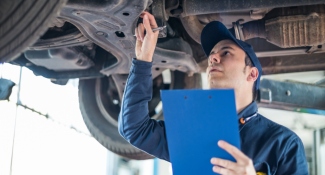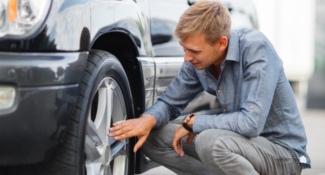Hail Damaged Cars – Should I Buy, Sell, or Keep?
Even if you have never experienced a hailstorm yourself, you have doubtless heard of the incredible amount of damage that hailstones can do. Residents of Missouri, Colorado, Kansas, and Nebraska are some of the most likely in the United States to experience a hailstorm, according to a March 2023 analysis by State Farm. Texas residents experience the most hailstorms per year by far, according to the same study.
Hail damage can occur on anything unprotected. Even things that are sheltered can have extensive hail damage if the hailstones are large enough to destroy the shelter. The horror stories of golf ball-size hailstones damaging buildings, vehicles, and other equipment seem to pop up on the news every year from somewhere in the U.S.
Hailstones do not have to be that large to cause extensive damage to unsheltered vehicles, though. Any size hailstones can cause small dents and dings all over a vehicle. Car owners must know what their options are to repair a hail-damaged vehicle, what their repair costs might be, and what they should consider if they are looking to buy a hail-damaged vehicle.
What Happens When My Car Gets Hail Damage?
Even though Texas sees the most amount of hail events each year in the United States, Minnesota residents accrued 799 million dollars in total hail damage claims in 2022, according to State Farm. 600 million total dollars of the 3.5 billion dollars in total hail damage claims paid were car insurance claims relating to hail damage.
That number is staggering, but it may not accurately represent the extent of the damage caused by hail every year. Some car owners may choose to overlook hail damage as merely cosmetic damage. After all, auto hail repair can be pricey, and the time it can take for an insurance adjuster to come out and look at a hail-damaged vehicle may be just as costly to an individual as going through the entire repair process itself.
It may be fine to overlook small dings and dents in some cases, but what may look like minor hail damage could have a greater impact on your vehicle than many realize. It is always a good idea to file an insurance claim with your auto insurance company and have an adjuster provide you with a repair estimate.
A comprehensive insurance policy usually covers hail damage, but it is always a good idea to check with your own insurance agent what your insurance covers and what the deductible is if it does. If you do not have comprehensive coverage, it may be worth checking to see what it would cost to get it, especially if you live in the Midwest where hailstorms are more frequent. Premiums can be higher here because of that, but it may save you thousands in hail damage repair costs one day.
Most of the time, at least exploring what it would take to fix hail damage on your car will benefit you in the long run. Even small hail dents can cause your vehicle’s resale value to plummet. Larger dings and dents that chip your vehicle’s paint open up the door for rust and corrosion to start damaging body panels and previously painted surfaces.
Naturally, the larger the hailstones are, the greater the chance your vehicle has of being totaled. If the insurance adjuster determines that car repair costs will exceed the total value of your vehicle, your vehicle could be declared a total loss by your insurance company.
Options for Repairing a Car with Hail Damage
Thankfully, there are several options on the table when it comes to repairing your hail-damaged vehicle. There may not be too many options if your vehicle is declared a total loss, but that is not always the case.
Nothing
Depending on your situation, you may not have to go to a repair shop to have your vehicle repaired. Two main factors might play into this option. The first one is the extent of the damage to your vehicle. If the hail damage is very minor and is not widespread, a car owner may choose not to file an insurance claim at all and leave the vehicle alone.
It is still a good idea to contact your insurance agent to have an adjuster come out, but if you choose not to do this, you will need to inspect the damage carefully yourself. If the vehicle’s paint is not chipped and there are only a few minor dings, you may think it is not worth the trouble.
The second factor is your intent with the hail-damaged vehicle. If you are sure that you will own the vehicle until it no longer runs, you may simply opt to skip the repair process as long as it runs and drives. This may also apply if the damaged car is a beater car or one that is just not worth that much anymore.
In either case, it is ultimately your choice what you do with the vehicle, especially if it runs and drives. Hail damage can greatly reduce the value of your vehicle, but if you intend to keep it until it no longer runs, you could save yourself both time and money.
Unfortunately, there is another side to this spectrum. If the hailstones are large enough and do enough damage to your vehicle to render it inoperable, you may simply be forced to buy a new car without being able to do anything about it.
DIY Repair
The second option is less ideal but could save you some cash if you can pull it off. DIY repair can be easy under certain circumstances. Minor hail damage could potentially be covered up with touch-up paint if the hail dents are superficial and scattered.
Most normal car owners do not have the tools at their disposal that repair shops do. Trying to repair much more than that could prove tricky and risky. If the hail damage is limited to a specific area like the hood, it may be a little easier since the hood can be removed. Simply buying a hood from a used car of the same model and installing it yourself may also be an option.
To ensure that any hail-damaged components of a vehicle are properly repaired, it is always a good idea to at least consult a body shop. There are plenty of car owners who are savvy enough to repair their own vehicles, and if you are one of them, you could save yourself some serious cash. Just remember that DIY repairs might cost less monetarily, but they usually cost more of your time than it is worth.
Paintless Dent Repair
Paintless dent repair or paintless dent removal is a process that removes dents without having to remove and repaint body panels. Body shops that do this kind of repair work may still have to remove some body panels, lights, and other components to access the back side of a dent, but this is much less extensive and invasive than a full body repair and repaint.
Paintless dent repair, or PDR, can usually be performed on small to moderate dings and dents, but it necessitates that the vehicle’s paint has not been damaged by hailstones. Regardless of whether or not your insurance coverage will pay for the hail damage repair on your vehicle, not having the extra expense of a repaint and the labor involved with that makes PDR a relatively low-cost body repair solution.
Repairs and Repaint
The most extensive and invasive repair process occurs when hail damage is such that it requires the vehicle to undergo extensive bodywork and a full repaint to restore its exterior to “like new” condition. After an insurance adjuster examines the vehicle and prepares a repair estimate, your insurance company will likely provide a list of approved body shops where the car repair can be completed if they have not declared the vehicle a total loss.
If you want to have this type of hail damage repair completed apart from your insurance company, it will likely be the costliest fix. Large hail dents or vehicle-wide hail damage that affects paint and body panels will take the most amount of labor to repair. Many repair shops charge per dent and can cost anywhere between $30 and $50 per dent, depending on the shop, location, and the extent of the damage.
Questions You Should Ask Yourself
With all of this information on the table, there are several questions you can ask yourself regarding a car with hail damage.
Should I Buy It?
Most of the information we have reviewed so far has to do with your vehicle. There may come a time when you want to buy a new car, and you find out that it has had hail damage in the past, though. The best answer to the question of whether or not you should buy it is multifaceted.
If the car has a salvage title as a result of extensive hail damage, it may be completely fine, but you will have to take some extra time to inspect the vehicle. Check to make sure that the repairs were completed well and that there is no visible damage to the car or its components. If the car was newer when the hail damage occurred, it could have been that the car owner had the repairs completed regardless of the insurance company’s decision to total it.
On the flip side, the repairs may have been done cheaply and quickly because an insurance company was unwilling to pay out for the car repairs. The previous owner could have still been upside down on the vehicle, and it was cheaper to have the car repaired quickly rather than well. Make sure to check for rust spots and corrosion on all body panels of the car.
It could be that the hail-damaged car has not even been repaired. This may turn out well for you as hail can have a drastic effect on a vehicle’s resale value. If the car is mechanically sound, there are only a few small dents and dings, there is no extensive paint damage, and you are willing to put up with the cosmetic damage, you may be able to get a great car for a great bargain.
At the end of the day, the question of whether or not you should buy a car with previous hail damage will depend on what you need, what you are willing to put up with, the condition of the car being sold, or all three of these factors. The risk involved with a hail-damaged vehicle may scare most normal buyers away, but there are certainly bargains to be had on the market if you are shrewd, you are careful, and you do your research.
Should I Sell It?
The question of whether or not you should sell your hail-damaged vehicle will also likely have to do with your current or future situation and preferences. The most obvious preference is whether or not you need your car to be cosmetically appealing. If you have to swallow the repair costs yourself, if the car has no mechanical issues, and if you do not want a car with all kinds of dings and dents, it may be time to move on to a new car.
There are buyers on the market who are certainly willing to have a car that is cosmetically imperfect but still runs and operates well. Some people go through the repair process after their insurance company approves their claim but know that the car has been damaged in the past. The feeling of owning a car and knowing that it has been damaged in the past is enough for some to sell the car after it has been repaired.
Owning a car that has been totaled because of hail damage can make a car owner feel the same way. Again, there is a population of buyers who are more than willing to take a vehicle with a salvage title knowing that the extent of the damage has mainly affected the exterior of a vehicle rather than the main powertrain or other important components.
The final question one should ask him or herself when deciding if they should sell their car is whether or not they can sell it in the first place and whether it is worth the hassle. The repair process for a heavily damaged car can be extensive, and trying to just get the car off of your hands and start fresh can be an appealing idea.
Conversely, selling a hail-damaged car without going through the repair process can be tough, depending on where you live. There are car buyers who are willing to buy a hail-damaged car or one with a salvage title, but finding the correct buyer who is willing to meet you on all the selling points you propose can be challenging.
Regardless of why you are asking if you should sell your hail-damaged vehicle, you should always disclose that the car has hail damage to potential buyers right off the bat.
Should I Keep It?
The question of whether you should keep your hail-damaged car goes hand-in-hand with the question of whether you should sell it. If you can deal with the fact that your car is or was damaged by hail, and it still runs well, you should definitely consider keeping it.
If you ended up taking a car loan to buy the vehicle in the first place, and you are still upside down, you should also definitely keep the car to prevent incurring even more debt. Hail damage can cause the value of your vehicle to plummet, so if you try to sell it, you may end up even further behind on your car loan, even if the car was fully repaired.
Lastly, you need to consider how much you love your car. Some people see vehicles as simple appliances. Others see them almost like family members. If you love your car and you know you want to keep it, then you should. Having a totaled car that still runs, drives, and functions well will not impact its daily drivability, and you may still get several years of use out of it.
If the hail damage is extensive enough, you should still consider repairing the car so that rust and corrosion do not damage it further.


